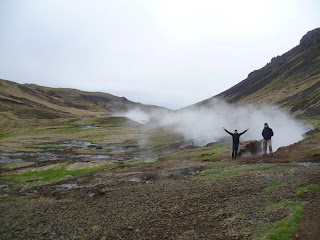Capital City
It
was a bit of a surprise to discover that the area I'm staying is in Reykjavik’s
downtown. Many of the streets are only wide enough to admit one or two cars,
bordered by wide sidewalks, cafés, houses, and small shops. Most buildings
are colored concrete or corrugated tin walls with steeped corrugated tin roofs.
Though most houses look similar, they distinguish themselves with colorings of
their roofs and walls, most being red, blue, yellow, white, and/or grays. The
day started out in the low 40’s (F) and rose to the 50’s. It’s been a bright,
sunny day with remarkably fresh air.


In the morning, we visited a church called Hallgrímskirkja
where, for a fee, we took an elevator up into the clock tower and looked out at
the city. Reykjavik is a seaside city, ringed in the distance by snowcapped
mountains. The effect is beautiful and makes the city feel exposed, a
vulnerable patch of humanity allowed to exist on this rocky land because, for
the moment, the environment is willing to humor humans.
Genetic Database
In 1998, Iceland created a genetic database, Íslendingabók,
that maps the enter population’s genealogical information extending back over
1,200 years. (The database gets interesting reference in Arnaldur Indrioason’s
Icelandic mystery novel Jar City).
In 2000,
Iceland seems to have sold the rights to access the database to deCODE, a US
biotech company. Iceland’s been pretty isolated (which has interesting results,
such as modern Icelandic being so close to old Nordic they can read the
original Norse sagas, and Iceland mostly playing traditional styles of music
until rock reached them). This also means it’s a great genetic sample for
studying genetic diseases; deCODE has been able to develop drugs to combat
heart disease, strokes, and asthma, and now offers them free to Icelanders.
This deal may have been part of settlement after the database was declared unconstitutional
in 2004; however, the database still exists.
Today’s Reykjavik
Grapevine (a entertainment/tourist focused free newspaper) reports that
deCODE celebrated its 10th anniversary with the Incest Spoiler alert,
a joke smart phone app. The idea is that before going home together Icelanders
can answer a few questions on their phone, at which point either an alarm goes
off telling them they’re too closely related, or a message encourages them to
get it on. One columnist was pretty pissed off because apparently,
international news got wind of this app and have been reporting as if Iceland
is a pool of incest and this app is all that stands between them and genetic
disaster.
Food
A classic food every guidebook mentions is Harofiskur, dried salted haddock. I
found it at the grocery store and it tastes exactly as I should have expected –
tough (it’s dried), salty (it’s salted) and with a fishy aftertaste (it’s
fish). So. That’s a food then.
Food’s expensive in Iceland.
Saga Museum: Settling
The Saga Museum provided a collection of choice anecdotes on
Icelandic settlers.
Originally, Irish monks found the island and stayed there
because its isolation meant nothing would interrupt their studying. When
“heathen” Norse arrived, the monks decided to ditch rather than stay in such
company. Later, Vikings raiders would enslave Irish; so many so that at the
time 20% of the men and 50% of the women in Iceland were Celtic (the rest were
Norse).
Early Norsemen navigated by noting the flights of migrating
birds in spring and autumn. The first Norseman to land on Iceland, Flóki
Vigerdarson, took three ravens on his ship to use in navigation. Then all his
livestock died and he left. Eventually a man called Ingolfor permanently
settled in Iceland.
Saga Museum: Let’s
Have a Religion
Iceland was divided between Christianity and belief in the
Norse gods. In 1000AD the government decided they needed one religion so as not
to divide the country. A single
member of the government, himself “heathen” as the museum called it, chose
Christianity, but said some heathen laws would stand and that you could practice
what you wanted in private. If you were caught, the punishment was three year’s
exile. The last Catholic bishop in Iceland, Jon Arasson, was beheaded in 1550;
against traditional Christian rules, he had many kids and most of Iceland is
related to him.
Saga Museum: Let’s
Have a Government
Most immigrants to Iceland came feeling oppressive European
kings, and so they approached choosing a government with care. They ended up
with the first Parliament, all members unpaid save for the Law Speaker, whose
job was to memorize and recite all of the country’s laws. Writing was adopted
around the time of the conversion to Christianity and laws recorded in books.
Saga Museum: Let’s all
Die
In 1402 a ship from England under Einar Herjolsson brought
the black plague. A third of Iceland died, but Einar was fine.
Saga Museum: Witches!
The first killed in Iceland’s witch hunt was a nun in 1343. Unlike
most other countries, men were most often accused of witchery.
Get the View
The Hallgrímskirkja church is a nice view, but really, you
want to go to Perlan/The Saga Museum (it’s the same building). While the church
top let’s you peak out of barred windows, the Pearl has an outside walkway,
offering an uninterrupted panoramic of Reykjavik (plus it’s free, while the
church charges $7/person to enter the tower).
Food
Food’s pricey here but not quite as pricey as it looks (I was assuming an Icelandic krona was 100th of a dollar, but it's more like 100 krona = US$0.81). It's about US$3.65 for a cappuccino or latte, and US $10.00 for a bowl of
lobster soup.
Saga Museum
It’s about US $20/person, which includes an audio guide. It’s
a small museum for the price. The audio-guide tells you anecdotes and tidbits
of settler history while you look at wax sculptures in traditional dress and
there’s a video explaining how the sculptures were made.



































